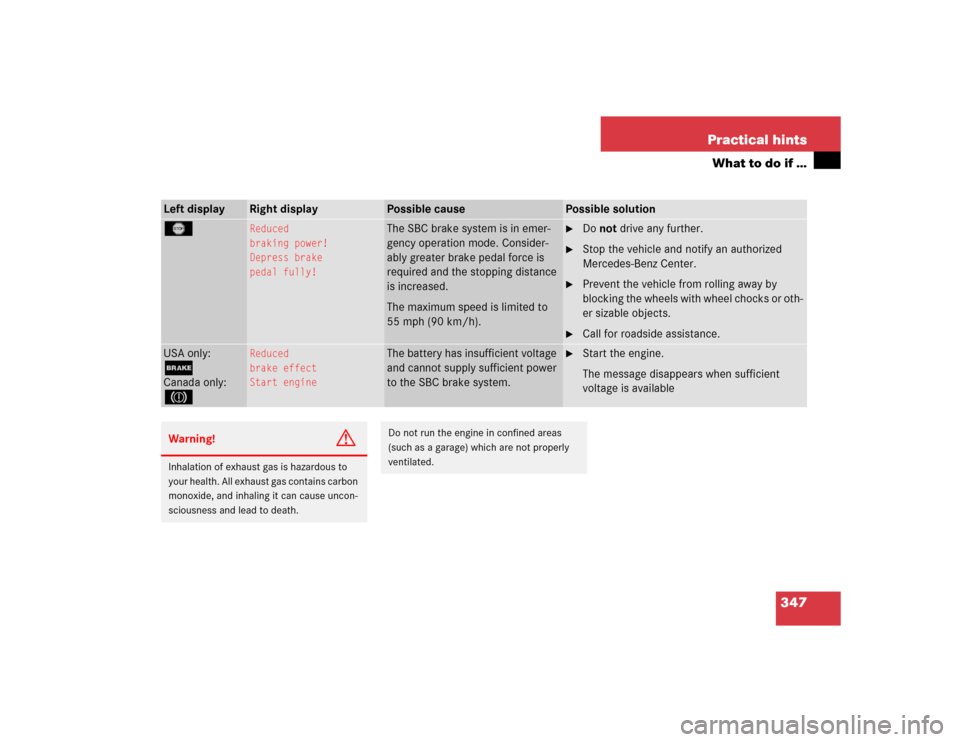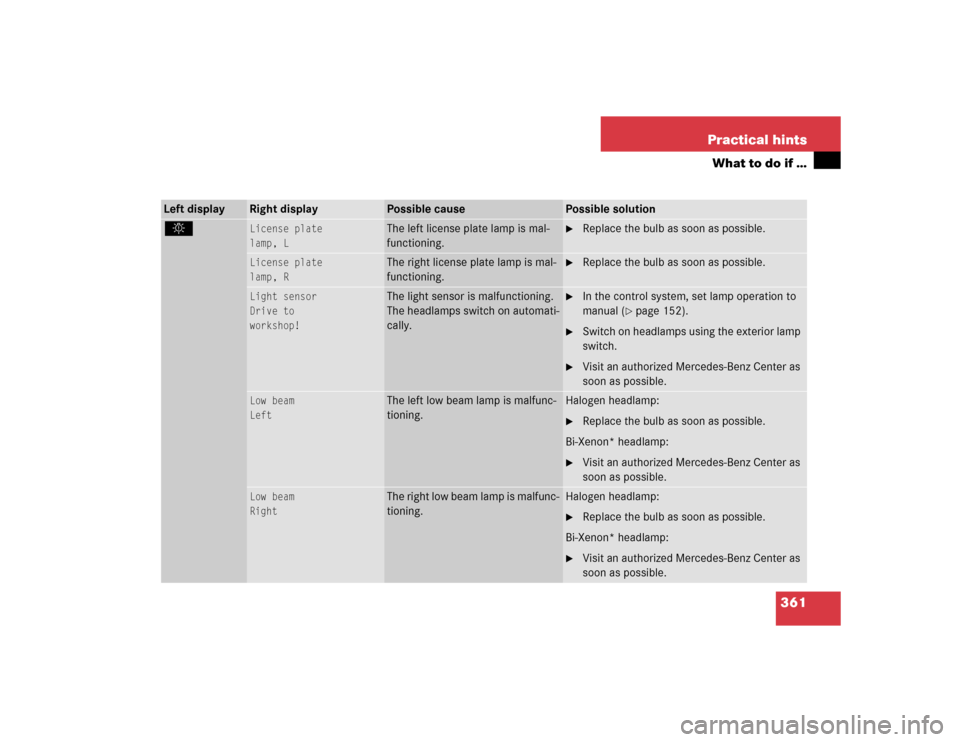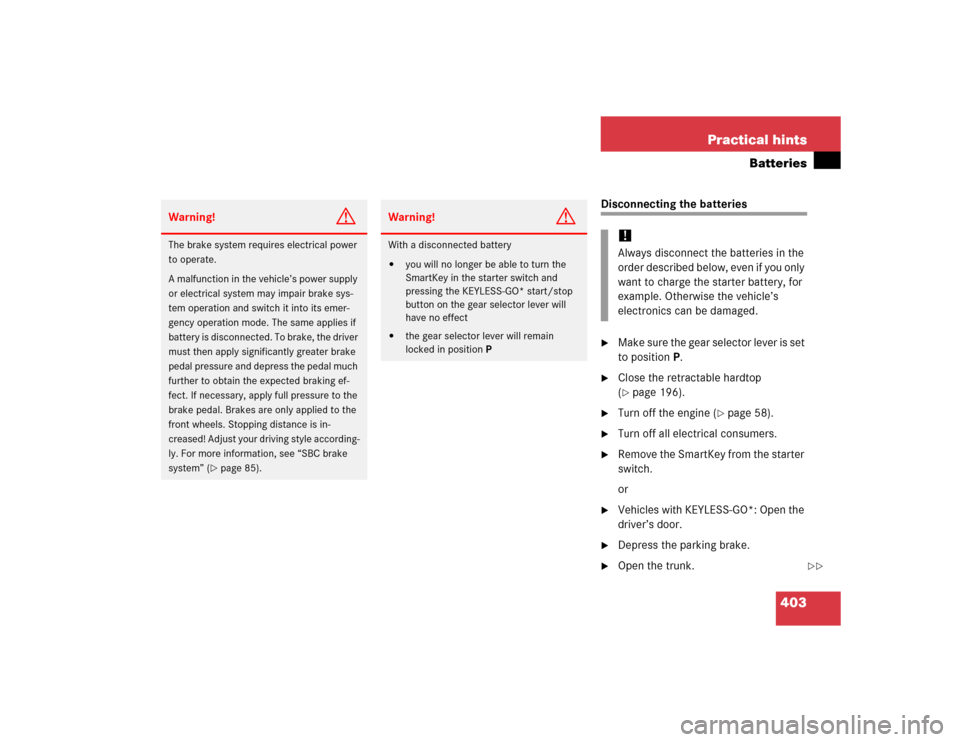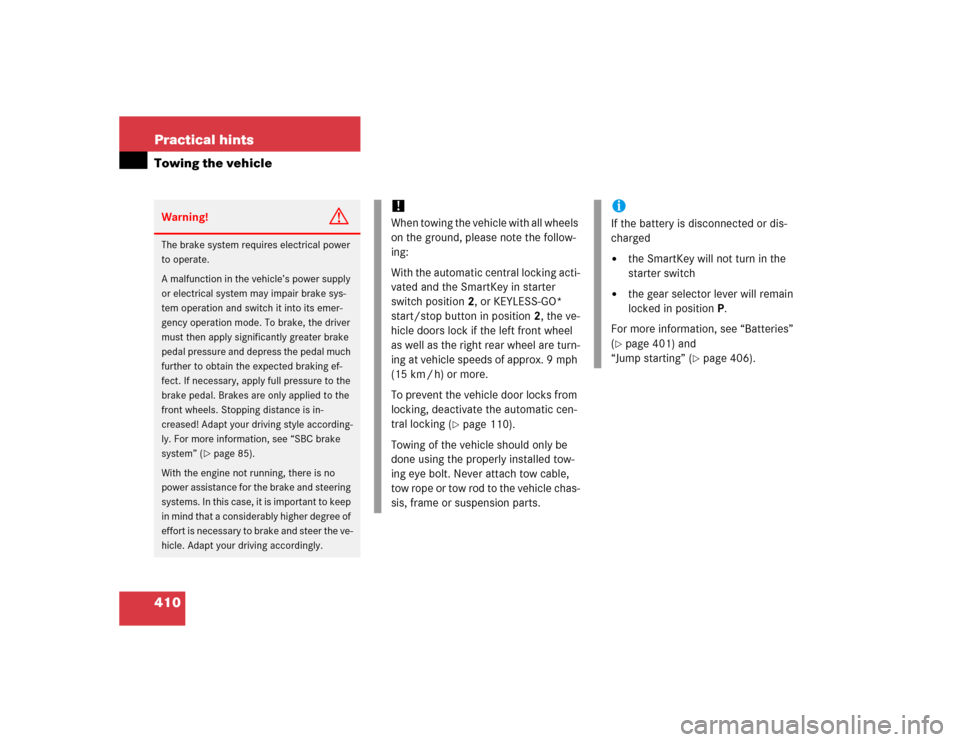Page 349 of 474

347 Practical hints
What to do if …
Left display
Right display
Possible cause
Possible solution
T
Reduced
braking power!
Depress brake
pedal fully!
The SBC brake system is in emer-
gency operation mode. Consider-
ably greater brake pedal force is
required and the stopping distance
is increased.
The maximum speed is limited to
55 mph (90 km/h).
�
Do not drive any further.
�
Stop the vehicle and notify an authorized
Mercedes-Benz Center.
�
Prevent the vehicle from rolling away by
blocking the wheels with wheel chocks or oth-
er sizable objects.
�
Call for roadside assistance.
USA only:;Canada only:3
Reduced
brake effect
Start engine
The battery has insufficient voltage
and cannot supply sufficient power
to the SBC brake system.
�
Start the engine.
The message disappears when sufficient
voltage is available
Warning!
G
Inhalation of exhaust gas is hazardous to
your health. All exhaust gas contains carbon
monoxide, and inhaling it can cause uncon-
sciousness and lead to death.
Do not run the engine in confined areas
(such as a garage) which are not properly
ventilated.
Page 350 of 474

348 Practical hintsWhat to do if …Left display
Right display
Possible cause
Possible solution
USA only:;Canada only:3
Reduced
brake effect
Visit
workshop
The SBC brake system is in emer-
gency operation mode. Consider-
able brake pedal force is required
and the stopping distance is in-
creased.
�
Continue driving with added caution.
�
Adjust driving to be consistent with reduced
braking responsiveness.
�
Visit an authorized Mercedes-Benz Center im-
mediately. Adjust driving to be consistent
with reduced braking responsiveness.
Warning!
G
Driving while these messages are displayed
can result in an accident. Have your brake
system checked immediately.
If there is a malfunction in the SBC brake
system, we recommend that the vehicle be
transported with all wheels off the ground
using flatbed or appropriate wheel lift/dolly
equipment.
A tow bar must be used if circumstances do
not permit the use of the recommended
towing methods and the vehicle requires
towing with all four wheels on the ground.
Towing the vehicle with all four wheels on
the ground is only permissible for distances
up to 30 miles (50 km) and at a speed not to
exceed 30 mph (50 km/h). For more infor-
mation, see “Towing the vehicle”
(�page 408).
If the SBC brake system enters its emergen-
cy operation mode, the driver must apply
significantly greater brake pedal pressure
and depress the pedal much further than
normal to obtain braking effect.
If necessary, apply full pressure to the brake
pedal. Brakes are only applied to the front
wheels. Stopping distance is increased!
Page 363 of 474

361 Practical hints
What to do if …
Left display
Right display
Possible cause
Possible solution
.
License plate
lamp, L
The left license plate lamp is mal-
functioning.
�
Replace the bulb as soon as possible.
License plate
lamp, R
The right license plate lamp is mal-
functioning.
�
Replace the bulb as soon as possible.
Light sensor
Drive to
workshop!
The light sensor is malfunctioning.
The headlamps switch on automati-
cally.
�
In the control system, set lamp operation to
manual (
�page 152).
�
Switch on headlamps using the exterior lamp
switch.
�
Visit an authorized Mercedes-Benz Center as
soon as possible.
Low beam
Left
The left low beam lamp is malfunc-
tioning.
Halogen headlamp:�
Replace the bulb as soon as possible.
Bi-Xenon* headlamp:
�
Visit an authorized Mercedes-Benz Center as
soon as possible.
Low beam
Right
The right low beam lamp is malfunc-
tioning.
Halogen headlamp:�
Replace the bulb as soon as possible.
Bi-Xenon* headlamp:
�
Visit an authorized Mercedes-Benz Center as
soon as possible.
Page 382 of 474
380 Practical hintsReplacing bulbsBulbs
Safe vehicle operation depends on proper
exterior lighting and signaling. It is there-
fore essential that all bulbs and lamp as-
semblies are in good working order at all
times.
Correct headlamp adjustment is extremely
important. Have headlamps checked and
readjusted at regular intervals and when a
bulb has been replaced. See an authorized
Mercedes-Benz Center for headlamp ad-
justment.
iIf the headlamps or front fog lamps are
fogged up on the inside as a result of
high humidity, driving the vehicle a dis-
tance with the lights on should clear up
the fogging.
iBackup lamps will be brought into use
when the following lamps malfunction:�
Turn signal lamps
�
Brake lamps
�
Parking lamps
�
Tail lamps
Observe the messages in the multi-
function display (
�page 335).
Page 405 of 474

403 Practical hints
Batteries
Disconnecting the batteries�
Make sure the gear selector lever is set
to position P.
�
Close the retractable hardtop
(�page 196).
�
Turn off the engine (
�page 58).
�
Turn off all electrical consumers.
�
Remove the SmartKey from the starter
switch.
or
�
Vehicles with KEYLESS-GO*: Open the
driver’s door.
�
Depress the parking brake.
�
Open the trunk.
Warning!
G
The brake system requires electrical power
to operate.
A malfunction in the vehicle’s power supply
or electrical system may impair brake sys-
tem operation and switch it into its emer-
gency operation mode. The same applies if
battery is disconnected. To brake, the driver
must then apply significantly greater brake
pedal pressure and depress the pedal much
further to obtain the expected braking ef-
fect. If necessary, apply full pressure to the
brake pedal. Brakes are only applied to the
front wheels. Stopping distance is in-
creased! Adjust your driving style according-
ly. For more information, see “SBC brake
system” (
�page 85).
Warning!
G
With a disconnected battery�
you will no longer be able to turn the
SmartKey in the starter switch and
pressing the KEYLESS-GO* start/stop
button on the gear selector lever will
have no effect
�
the gear selector lever will remain
locked in positionP
!Always disconnect the batteries in the
order described below, even if you only
want to charge the starter battery, for
example. Otherwise the vehicle’s
electronics can be damaged.
��
Page 412 of 474

410 Practical hintsTowing the vehicleWarning!
G
The brake system requires electrical power
to operate.
A malfunction in the vehicle’s power supply
or electrical system may impair brake sys-
tem operation and switch it into its emer-
gency operation mode. To brake, the driver
must then apply significantly greater brake
pedal pressure and depress the pedal much
further to obtain the expected braking ef-
fect. If necessary, apply full pressure to the
brake pedal. Brakes are only applied to the
front wheels. Stopping distance is in-
creased! Adapt your driving style according-
ly. For more information, see “SBC brake
system” (
�page 85).
With the engine not running, there is no
power assistance for the brake and steering
systems. In this case, it is important to keep
in mind that a considerably higher degree of
effort is necessary to brake and steer the ve-
hicle. Adapt your driving accordingly.
!When towing the vehicle with all wheels
on the ground, please note the follow-
ing:
With the automatic central locking acti-
vated and the SmartKey in starter
switch position2, or KEYLESS-GO*
start/stop button in position2, the ve-
hicle doors lock if the left front wheel
as well as the right rear wheel are turn-
ing at vehicle speeds of approx. 9 mph
(15 km / h) or more.
To prevent the vehicle door locks from
locking, deactivate the automatic cen-
tral locking (
�page 110).
Towing of the vehicle should only be
done using the properly installed tow-
ing eye bolt. Never attach tow cable,
tow rope or tow rod to the vehicle chas-
sis, frame or suspension parts.
iIf the battery is disconnected or dis-
charged�
the SmartKey will not turn in the
starter switch
�
the gear selector lever will remain
locked in positionP.
For more information, see “Batteries”
(
�page 401) and
“Jump starting” (
�page 406).
Page 415 of 474
413 Practical hintsFuses
Opening�
Open the hood (
�page 270).
�
Move slide to position 2 and lift
cover1.
Closing
�
Hook cover 1 onto tabs and close it.
�
Move slide to position 3.!The fuse box cover must be properly
positioned with the slide at the ‹
symbol to prevent moisture or dirt from
entering the fuse box and possibly im-
pairing fuse operation.
Page 422 of 474
420 Technical dataEngineModel
SL 500 (230.475)
1
SL 600 (230.476)
1
Engine
113
275
Mode of operation
4-stroke engine, gasoline injection
4-stroke engine, gasoline injection
No. of cylinders
8
12
Bore
3.82 in (97.00 mm)
3.23 in (82.00 mm)
Stroke
3.31 in (84.00 mm)
3.43 in (87.00 mm)
Total piston displacement
303.0 cu in (4966 cm
3)
336.4 cu in (5 513 cm
3)
Compression ratio
10:1
9:1
Output acc. to SAE J 1349
302 hp / 5 600 rpm
2
(225 kW / 5 600 rpm)
493 hp /5 000 rpm
2
(368 kW / 5 000 rpm)
Maximum torque acc. to SAE J 1349
339 lb-ft / 2 700 rpm
(460 Nm / 2700 rpm)
590 lb-ft /3 500 rpm
(800 Nm /3 500 rpm)
Maximum engine speed
6000 rpm
5750 rpm
Firing order
1-5-4-2-6-3-7-8
1-12-5-8-3-10-6-7-2-11-4-9
Poly-V-belt
2390 mm
2335 mm
1The quoted data apply only to the standard vehicle. See an authorized Mercedes-Benz Center for the corresponding data of all special bodies and special equipment.2Premium fuel required. Performance may vary with fuel octane rating.